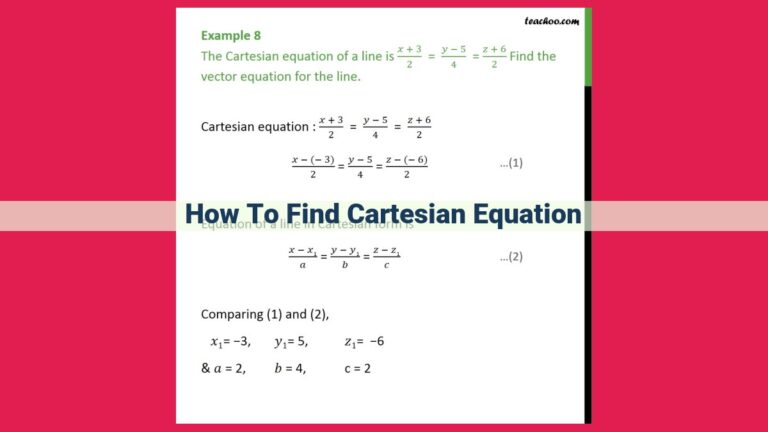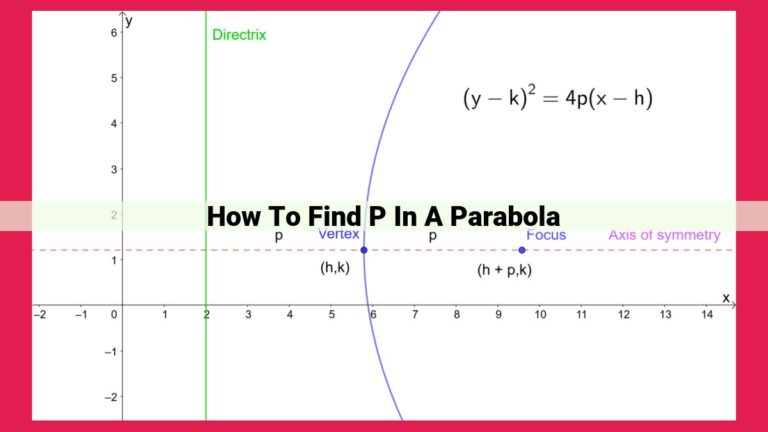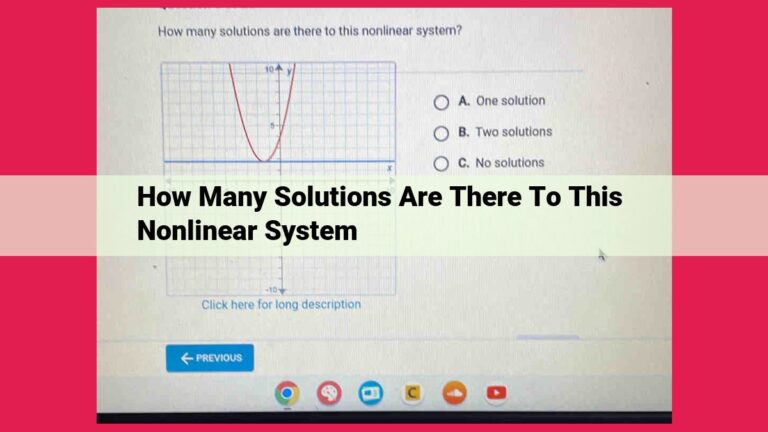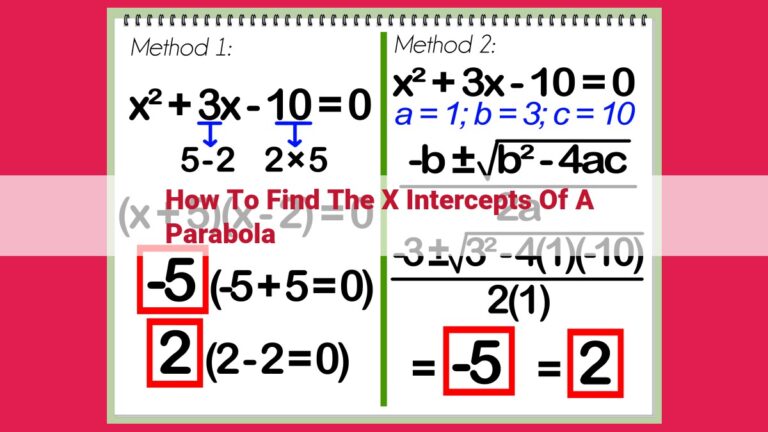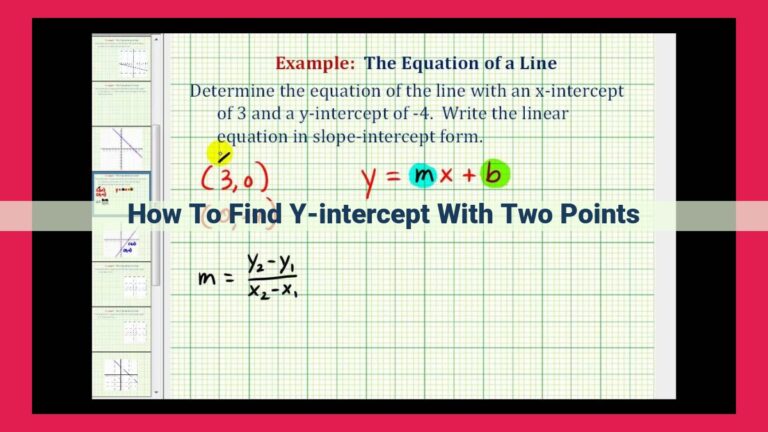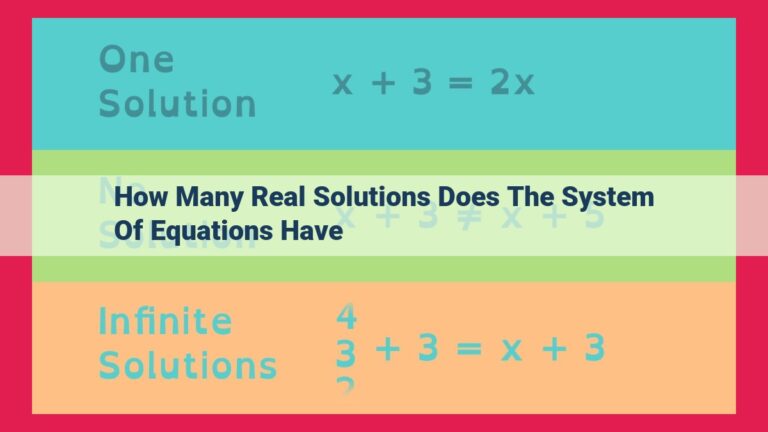Determining Equation Solutions: The Discriminant’s Role In Real And Complex Outcomes

The number of solutions to an equation is determined by its degree, leading coefficient, constant term, and the discriminant. The discriminant is calculated using the equation’s coefficients and it determines the number of real and complex solutions. A positive discriminant indicates two real solutions, a zero discriminant indicates one real solution, and a negative discriminant indicates two complex solutions. The nature of the solutions (real or complex) is determined by the discriminant’s sign, while the rational or irrational nature of real solutions depends on the square root of the discriminant.
Understanding Equation Characteristics
Embark on a Journey to Uncover Equation Secrets
In the realm of algebra, equations hold the key to unlocking hidden knowledge. To master these enigmatic puzzles, we must first understand their intrinsic characteristics, which serve as a compass guiding us towards their solutions. Join us on an exploratory adventure as we decipher the secrets of equation characteristics.
The Equation’s Degree: A Measure of Complexity
Every equation has a degree, a number that determines its level of complexity. This degree is equivalent to the highest exponent of the variable. For instance, an equation of degree 2, known as a quadratic equation, contains variables raised to the power of 2.
The degree of an equation unveils important information. It dictates the maximum number of solutions the equation can have. Quadratic equations, with a degree of 2, have a maximum of two solutions.
The Leading Coefficient: A Force that Shapes the Discriminant
The leading coefficient is the numerical value that multiplies the variable with the highest exponent. This coefficient plays a pivotal role in shaping the equation’s discriminant, a crucial factor that determines the nature and number of solutions.
The Constant Term: A Balancing Act
The constant term is the value that stands alone in the equation, without any variable attached to it. This term influences the discriminant, affecting the location and behavior of the solutions.
The Discriminant: Unlocking the Secrets of Quadratic Equations
In the realm of algebra, quadratic equations hold a captivating charm. These equations, of the form ax² + bx + c = 0, offer a glimpse into the hidden depths of mathematical intricacies. At the heart of these equations lies a pivotal concept: the discriminant. Like a key that unlocks a treasure chest, the discriminant reveals the secrets of the equation, guiding us to the number and nature of its solutions.
Definition and Calculation
The discriminant, denoted by the Greek letter Δ (Delta), is a mathematical expression that encapsulates the coefficients of a quadratic equation:
Δ = b² - 4ac
Here, a, b, and c are the coefficients of the quadratic equation ax² + bx + c = 0. The value of Δ provides us with crucial information about the equation’s solutions.
Significance
The discriminant plays a pivotal role in determining the number and nature of solutions an equation possesses. It acts as a signpost, guiding us towards the following possibilities:
- Δ > 0: Two distinct real solutions
- Δ = 0: One real solution (repeated root)
- Δ < 0: Two complex solutions (no real solutions)
The discriminant’s value reveals the equation’s behavior, ensuring that we approach it with the appropriate techniques and expectations.
Number of Real Solutions: Unraveling the Secrets of the Discriminant
Embark on a mathematical journey as we delve into the concept of real solutions and their harmonious relationship with the enigmatic discriminant. Just like a lock and key, the discriminant holds the power to unlock the mysteries of equations, revealing the number and nature of their solutions.
The discriminant, like a celestial sentinel, stands as the guardian of real solutions, its value dictating their existence and quantity. Calculated using the equation coefficients, this numerical gatekeeper determines the path of our mathematical journey.
When the discriminant whispers a positive tale, it signifies the presence of two distinct real solutions. These solutions emerge as two separate numbers, each carrying its own mathematical identity. Like two parallel lines, they coexist without ever crossing paths.
However, when the discriminant remains in the realm of negativity, a different story unfolds. This scenario unveils no real solutions. The equation, like a ship lost at sea, fails to find safe harbor in the world of real numbers.
But there’s a twist in the tale. If the discriminant dares to dance on the delicate line of zero, a single real solution emerges from the mathematical mist. This lone solution stands as a solitary island, its existence a testament to the delicate balance of the equation.
Understanding the number of real solutions is crucial, for it serves as a guidepost in our mathematical explorations. It helps us anticipate the outcomes of equations, guiding our path toward the ultimate resolution.
Number of Complex Solutions
Determining the Number of Complex Solutions
The discriminant plays a crucial role in determining not only the number of real solutions but also the number of complex solutions. Complex solutions are solutions that involve the imaginary unit i, which is defined as the square root of -1.
The derivation of the number of complex solutions from the discriminant is similar to that of real solutions. If the discriminant is negative, then the equation has no real solutions. However, in this case, it has two complex solutions.
Interpretation of Complex Solutions
The interpretation of complex solutions is somewhat different from that of real solutions. When the equation has two complex solutions, they are always conjugates of each other. This means that they have the same real part but opposite imaginary parts.
For example, if one complex solution is a + bi, then the other complex solution will be a – bi.
It’s important to note that complex solutions are not real. They are used to solve equations that do not have real solutions. However, they are still valid solutions to the equation, and they play an important role in many areas of mathematics and science.
Nature of the Solutions: Unveiling the Secrets of Real and Complex Numbers
As we delve deeper into the fascinating world of equations, we encounter the enigmatic realm of solutions – a tapestry woven from the threads of real and complex numbers. Understanding the nuances of these solutions is crucial for navigating the equations’ intricate landscapes.
Real vs. Complex: A Tale of Two Worlds
In the realm of numbers, the real reside as tangible entities that we encounter in our everyday lives. They encompass the realm of positive and negative integers, fractions, and decimals. Complex numbers, on the other hand, venture beyond the familiar, incorporating the imaginary unit i, defined as the square root of -1. This unique characteristic sets complex numbers apart and grants them an ethereal, almost magical allure.
Determining whether solutions are real or complex hinges on the discriminant. A positive discriminant heralds the presence of two distinct real solutions, their values distinct and separate. Conversely, a negative discriminant ushers in the realm of complex solutions, a pair of solutions intertwined, their values inseparable without the guiding hand of i.
Rational vs. Irrational: A Matter of Precision
Among real solutions, a further distinction emerges: rational versus irrational. Rational solutions are those that can be expressed as a fraction of two integers, precise and calculable to any desired degree of accuracy. Irrational solutions, however, defy such simplicity, extending indefinitely beyond the confines of a fraction. They dance along a continuum, their decimal expansions stretching out into an endless waltz of digits.
Identifying rational solutions requires a keen eye for patterns. If a solution can be expressed as a fraction of integers or a finite decimal, it proudly wears the mantle of rationality. Irrational solutions, on the other hand, reveal themselves through their infinite, non-repeating decimal expansions.
By unraveling the nature of solutions – grasping the distinction between real and complex, and discerning rational from irrational – we equip ourselves with a compass to navigate the uncharted waters of equations. This knowledge empowers us to decipher their secrets, foresee their solutions, and conquer the challenges they present with confidence and understanding.
